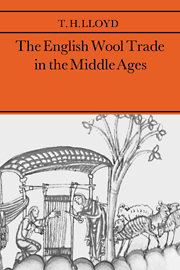Book contents
- Frontmatter
- Contents
- List of Tables and Maps
- Preface
- Abbreviations used in Notes and Bibliography
- 1 The growth of the Flemish connection
- 2 The end of the Flemish ascendancy
- 3 The Italian hegemony
- 4 The English triumphant
- 5 Edward III – woolmonger extraordinary
- 6 Quest for a staple policy
- 7 The evolution of the Calais staple
- 8 The decline of the wool trade
- 9 Marketing the wool
- Notes
- Bibliography
- Index
1 - The growth of the Flemish connection
Published online by Cambridge University Press: 10 December 2009
- Frontmatter
- Contents
- List of Tables and Maps
- Preface
- Abbreviations used in Notes and Bibliography
- 1 The growth of the Flemish connection
- 2 The end of the Flemish ascendancy
- 3 The Italian hegemony
- 4 The English triumphant
- 5 Edward III – woolmonger extraordinary
- 6 Quest for a staple policy
- 7 The evolution of the Calais staple
- 8 The decline of the wool trade
- 9 Marketing the wool
- Notes
- Bibliography
- Index
Summary
In 1297, at the height of a constitutional crisis, the English barons advanced the claim that nearly half their country's wealth derived from wool. Although in one sense an exaggeration, in another this statement is less than the truth for, although wool cannot have made up anything like half the gross national product, it contributed nearly all the country's export earnings. Yet while the wool trade was then the most important branch of English commerce it was not necessarily the oldest, for woollen cloth was sent abroad long before there is evidence of the export of raw wool. The medieval export trade may be represented, perhaps, as a cycle in which the earliest and latest periods were distinguished by manufactured woollen cloth, the volume in the last being vastly greater than in the first, while intermediate stages in the cycle saw the growth and the decline of the wool trade. During the first half of the eighth century gifts of cloaks were sent to English missionaries on the continent and, although this can hardly be described as commerce, Charlemagne's letter to Offa of Mercia later in the same century, complaining about English cloaks and requesting that they should be made as of old, suggests a trade of some standing. There is a possibility that English cloth went into the famous ‘Frisian cloaks’ which had wide currency at that time, and by the ninth and tenth centuries the fame of the English product had reached the Arab world.
- Type
- Chapter
- Information
- The English Wool Trade in the Middle Ages , pp. 1 - 24Publisher: Cambridge University PressPrint publication year: 1977



